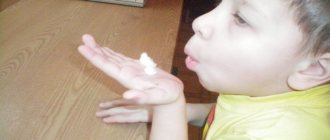June 27, 2016
Averyanova Sveta
Modern children read poorly. This affects academic performance, the amount of material absorbed in class, and the speed of completing homework. Special speed reading exercises for children help solve the problem.
This is a unique technique. It is used in additional education schools and for home lessons with parents. What is its peculiarity and how to teach a child to read quickly to himself and out loud, you will learn from our article.
At what age to start
There are several opinions about what age you should start teaching your child to read fluently and meaningfully. Some teachers believe that you should start teaching your child before school, others - when the child enters 1st grade, and some - at an even older age.
In the beginning, experts advise teaching your child to read syllable by syllable.
According to the methods of Zaitsev, Doman, Montessori
The optimal period is considered to be from 3 to 7 years. The brain of a preschooler or first-grader remembers information quickly and firmly.
According to the Waldorf school
To firmly master the skill, children must grow to 10–12 years of age. This is due to the fact that elementary school students perceive information well when spoken at a normal speech rate. By intermediate level, the ability to understand rapid streams of phonemes will improve. Reading technique is accelerated.
Having combined and analyzed both opinions, we can say for sure that it is not worth doing speed reading with first-graders and preschoolers persistently, under pressure. It is better to postpone this until a later period, when the child is mature. In elementary school, use preparatory exercises to develop memory, attention, and articulation.
These classes are useful for increasing the pace of text assimilation in the future.
Important! For early learning of the alphabet and syllables, use Zaitsev's cubes. They can be used from 6 months of age to introduce letters in a playful way.
So, in short:
Reading diagonally
and trying to take in the entire page with your eyes hardly have anything in common with real reading. Most of the text in this case falls into the peripheral vision zone and simply cannot be read. These techniques do not allow you to read text, but they can be used to quickly skim through material you already know.
Reading without stopping
- also not the best way to save time. This approach significantly reduces our ability to perceive material. As a result, you will be able to quickly read the text, but remembering and retelling its content will be extremely difficult.
Suppression of subvocalization
- another poorly working technique. Research shows that the reader always pronounces the text to himself, even if he is sure of the opposite. Moreover, subvocalization helps us understand what we read better. Instead of suppressing it, it is worth expanding your vocabulary - it takes us less time to internally pronounce familiar words, and this skill is not related to the ability to quickly read aloud.
RSVP
– this technique works, but with limitations. You will be able to read faster, but you are unlikely to increase your reading speed many times over. In addition, the features of this technique make it difficult to use in cases where you need to read complex material (for example, an article from a scientific journal on a topic that is new to the reader). Reading for pleasure in this format is also inconvenient. The ideal option is mail, news notes and articles like this one.
In the third [and final] part, we will talk about cases when you still cannot do without speed reading, what “slow” reading is, and how to save time on reading “serious” scientific literature - without resorting to complex techniques.
PS Other materials from ITMO University:
- How tech entrepreneurship and science fiction relate
- Postgraduate studies at ITMO University: the main thing about admission and study in 2021
- Polymer holograms with “escaping” nanoparticles were developed by university scientists
- EMI life hacks: how to teach in English if you are not a native speaker
Don't Make These Mistakes
Often, even capable children show poor readiness for reading due to methodological errors at the initial stage of learning syllabification. Self-study at home has an impact. Parents commit the following typical violations:
Tell the baby a letter, not a sound
For example, “Pe”, “Ne” and so on. This is not true. The names of letters from the alphabet must be pronounced without an additional sound: “K”, “M”...
Memorizing letters with overtones will lead to problems with reading. The child puts the syllables together like this: “pea-pea” instead of “pa-pa.” Short and clear sound pronunciation is the main rule and condition for a fast reading pace.
Compose syllables from individual letters
Assignment: look, “b” and “o”, it turns out “bo” - methodologically incorrect. Teach children to immediately extend the vowel, without a pause between sounds: “bo-o-o-o.” Avoid spelling words. This is easier for children, but it takes time to analyze words into their component parts, and the meaning of phrases is lost.
They read texts for a long time
Conduct classes often, spend 5-7 minutes on one thing. It is better to read a short passage from the text, a couple of sentences at a good speed, than to keep a student at the table for half an hour and force him to study. Short lessons are more effective. Don't forget to take breaks between exercises, about 2-3 hours.
Important! Consider the child’s mental characteristics: memory capacity, maximum attention span.
If a teenager can concentrate and study for 15-20 minutes, it is not tiring, increase the duration of the lesson, but reduce the number of lessons per day to one or two.
Useful tips on how to learn to read well and quickly
As you learn to quickly process written information, you should use the following tips.
Don't say the words
Try to read only with your eyes. Even at school, we get used to pronouncing words in a whisper when we read a text. This interferes with speed reading. It is known that moving the lips slows it down. So break this habit if you want to speed up your reading.
Don't come back
Often, when the reader finishes a line, he returns to the one he just read. This slows down the pace significantly. Try not to return to the same line several times; it is better to use a ruler or your index finger.
Don't miss the text
An amazing technique is text tracking. Turning your head and using your hands to help speed up the reading process. Connecting peripheral vision is very useful for mastering a huge amount of information.
Learn
Don't forget that any skill requires dedication and training. You can learn how to read better from books. For example, the book by E. A. Nefedova and O. V. Uzorova “The fastest way to learn to read” will be very useful for you. Syllable tables.” These authors also help you learn to read English quickly.
Video
Also be open to receiving helpful tips from video sources. See one of them below.
From simple to complex
Speed reading training is based on the ability to perceive words as a whole, without dividing them into syllables. At the initial stage, use short words consisting of two or three sounds. For example, “house”, “cat”. In the future, the baby will not read them or recognize them by letters. He will see this word in the text and immediately pronounce it. This is the meaning of the speed reading technique.
Preparation for the lesson: write the simplest words on a piece of paper, one at a time. Show them one after the other. As you complete the exercise, gradually increase the pace of changing words. Replace three-letter lexemes with words of four–five–seven letters after a solid assimilation of the material covered.
Words (“house”, “forest”) are replaced with complex ones (“tree”, “car”), then phrases and phrases. Compose sentences from vocabulary familiar to students. For example, he can read “who” and “house” separately. Suggest the phrase: “Who is in the house,” then add “lives” to this. You will get an offer.
You can start reading short texts when the student has mastered the ability to quickly read phrases and phrases. The pace of skill consolidation is different for all children. Do not rush if the student hesitates. Sometimes you need to return to simple, already covered material. This will increase interest in classes, reduce emotional stress, and set you up for success.
And only in this case will the fast reading technique produce results.
Important! For your first books, use bright literature, with pictures, and an interesting plot. A boring curriculum will not do.
Exercises for first graders
First grade is the most difficult psychologically, but very interesting period of life. During the first months at school, the child adapts to the new team, teacher, learns discipline and learns a lot of new things. It is not recommended to start fluent reading classes in the first half of the year. A first-grader simply does not have enough strength and emotions for the additional load at home.
If you feel that your child can and wants to become the first in reading technique among his classmates, then conduct lessons in the form of a game, without forcing him to sit for a long time in front of a book.
According to Professor I.T. Fedorenko, the author of his own method of teaching reading, the effectiveness of classes depends not on the amount of time spent on the lesson, but on its quality. Organize a clear pattern: do simple exercises for 5-6 minutes two or three times a day. If a student is not in a good mood or is tired, postpone the lesson for a couple of hours, let him rest and get ready for work.
Important! Rest means a walk, active games, lunch or an extra afternoon snack. Do not allow sitting near the TV or computer. Watching cartoons or playing online games on the Internet does not relieve the student psychologically.
If you decide to study with a first grader at home, without the help of professionals, use the following exercises:
Automated syllable reading
Download it online for free or make your own syllable table.
For example, like this:
A first grader can become familiar with it while learning the alphabet.
The syllable table is used in every lesson. A first grader reads one to three lines in one lesson, gradually accelerating the pace. If training takes place in a group, then first the lines from the syllabic table are pronounced in chorus, then individually.
Thanks to the syllabary table, the student easily understands the structure of words and learns to read words faster—automatically. Letter combinations are pronounced vertically and horizontally. During the introductory lesson, it is better to carefully practice one line with the same vowel: GA, YES, etc. Read the syllables slowly, without dividing them into sounds.
The benefits of a syllabic table are invaluable in speech therapy classes: the articulatory apparatus is trained, problem sounds are identified. Thanks to the use of a table of syllables for training reading skills, while simultaneously improving speech, the child acquires spelling skills and neutralizes the tendency to dysorthography.
Choral reading
Used as a warm-up at the beginning of the lesson. Kids receive pieces of paper with text, preferably poetry, or sayings. The material is read in chorus at an average pace. Then each student pronounces the chosen tongue twister in a whisper or loudly. This trains articulation.
Set of tasks
Includes the following exercises:
- repeated reading for speed and time;
Children are offered a text. They read it on their own, quietly. The teacher times 1 minute. After stopping, children mark with a pencil the place where they stopped.
Rest for 3–5 minutes. At this time, you can speak tongue twisters. Do articulatory gymnastics.
- reading at a good pace;
We take the familiar text in our hands and read it again for a minute. We compare the first and second results. More often than not, children read familiar passages faster and make fewer mistakes. Success creates a positive attitude. Let's move on to new material.
- getting to know a new text and reading it with expression;
For lessons in which reading techniques are practiced, it is better to take texts that cannot be read fluently in a minute. Children should still have a piece of new material to practice speed reading. Read the unfamiliar part of the text in unison, quickly, but with expression.
Use a set of exercises in each lesson for 1-2 weeks.
Task "Tug"
This task is as follows: the lexical material is read together with the parent. The adult chooses a pace so that it is not difficult or too easy for the child. Two or three sentences are read in chorus, the parent falls silent, continuing to read silently.
The kid doesn’t stop either, he reads to himself, trying to maintain the set speed. After one or two sentences, the adult begins to pronounce the text out loud. If the student does not slow down, he will read the same thing with his parent.
This exercise can be done in pairs. Children distribute roles. The strong student plays the role of a tug, and the weak one pulls up behind him. For the first lessons using this scheme, use a hint: move your finger over the text while silently reading. The student who follows the strong one will continue reading aloud, guided by the partner's prompt and his speed.
Jump-stop
The exercise is like a game. Develops attention, visual memory, orientation in the text.
The task is performed as follows. A child sits at a table with a text in front of him. At the command of an adult, he begins reading at a high speed rhythm. When the order to stop is given, the child closes his eyes and rests for 10–15 seconds. Then the teacher gives the command to read.
A first grader needs to quickly find the stopping point in the text and continue reading. This is an easy way to improve attention and visual memory.
Important! No need to help find the stopping place in the book. The reception is based on the principle of complete independence.
Half
Prepare didactic material. Write words of two or three syllables on an A4 sheet of paper, large. For example, “cat”, “spoon”, “girl”. Then cut the sheets so that the words can be folded from two halves. Shuffle the cards.
Offer to find and put together parts of words in a playful way at speed. But speed is not the most important thing here.
A properly conducted lesson develops imagination and memory.
For reference! An interesting method of teaching children to read from the cradle are Doman-Manichenko cards. These are pictures with words. They are shown to the child quickly, 2-3 seconds. Four to ten a day. After 5 days, the baby will name the words written on the card. The method is based on photo memory.
Here is another interesting method, which is very simple and at the same time effective, as it helps you quickly learn to read.
For children over 8 years old
Continue improving your reading speed in second grade. Eight-year-old children are independent and fast. They have outgrown the first grade activities, so offer them other fun exercises and games:
Looking for a word, line
The meaning of the game: a schoolchild (2nd grade) finds all the words in the text that begin with the same letter. Searching for a whole phrase is a more complicated version of the task.
The exercise teaches attentiveness and develops the left hemisphere of the brain - the linguistic one.
Insert letters
A second grader is presented with a text with missing letters. To read it and understand it, you need to think of endings and prefixes. This speeds up the pace of text comprehension in the future and helps to combine letters into whole words.
Fixing the error
The teacher reads the text, the children follow. The teacher deliberately makes a mistake in the ending of a word, root, etc. The task of a 2nd grade student is to correct the inaccuracy.
Read at speed
A second-grader independently takes measurements of reading technique, timing a minute, and keeps a diary of successes. Normally, by the second grade, children read at least 70 words, in the third - 100 words, in the fourth - 120.
Playing "Hidden Words"
The game is similar to reading anagrams. Children find words (large and small) in the field with letters. It looks like this:
Words can be selected on one topic or randomly. It is better for primary school students to provide a list of words that need to be found, leaving the task of isolating them on the field.
And one more option that you can print and use with your child.
Reading and counting
A second grader reads the text and counts the given sounds. For example, in the following poem, find out the number of “o” sounds.
The ball is bouncing along the path,
We can't catch the fast ball.
Develops multitasking skills and concentration.
What does speed reading give a person?
The benefits of speed reading will be especially appreciated by people dealing with large volumes of text. Lawyers, philologists, historians, teachers, scientists. Speed reading allows them to seriously increase the efficiency of their activities.
Speed reading skills will be very useful during your studies. Pupils and students will be able to spend less time memorizing material, understand it better and eliminate pointless cramming.
As you can see, the method has a lot of advantages. The only negative is the difficult and slow process of mastering it. You will have to show persistence and self-discipline to start learning speed reading and not give up halfway. But this is a feature of all effective methods of self-development. Do you want to get results? Please work hard!
Special exercises
Expanding the field of view
- Shulge table.
Necessary to increase the viewing angle. For second graders, use this version of the table:
The child looks for numbers in order with his eyes: from 1 to 25, for example, only black or only red. Record your time and limit it gradually. Searching for numbers in the table will increase the rate of speech, since the student will see more words with peripheral vision, that is, subconsciously read them in advance.
- Wedge tables.
The student needs to concentrate his gaze on the top numbers, gradually moving down. The numbers are spoken out loud. After several exercises using a wedge-shaped table, the student will see all the signs on the left and right at the same time. Download teaching materials from letters and numbers on the Internet.
Regression Suppression
Returning your gaze to a line you’ve already read – regression – greatly slows down the pace of reading. To get rid of the unwanted effect, use the following training exercises:
- Indicate the reading direction.
Take a pointer or pencil and move it forward along the lines. The child intuitively follows the pointer without looking back.
- Close the text you read.
Prepare a special bookmark for the student.
Have the second grader place it at the top of the text, gradually moving it down as they read. This way the read passage will be hidden from view. It is impossible to return to him.
- Check your speed constantly.
Measure your reading technique every day. To improve your results, you will always have to move forward without looking back.
Articulation suppression
Younger schoolchildren often cannot read to themselves without pronouncing words with their lips, even silently. This is unacceptable for speed reading. Articulation must be suppressed. The technique of sliding the eyes over the text is trained as follows:
- musical accompaniment;
We read to music without words, then with a song on. Pay attention to understanding the meaning of the text.
- "Bumblebee";
Ask students to hum while reading. This is a complex but effective method.
- rhythm;
Read and drum with your fingers and pencil on the table. Gradually increase the pace.
- lock;
Press your lips tightly and cover your mouth with your palm. We read to ourselves at the highest possible speed.
Important! After reading, ask the student questions about the text to check their reading comprehension.
Exercises to correct attention and concentration
Without a high level of attention, it is impossible to read quickly and at the same time understand what the text is about and highlight the main thing. To adjust your attention and concentration, do the following exercises:
- We make up words.
Take a long word. For example, "representation". Short words are made from it: “forest”, “shaft”, “toast”, “harm” and others.
- Finding differences.
In pairs: “horse - laziness”, “sleep - tone”, “kitty - fox”, differences are looked for. It is necessary to explain in detail how they are similar and different.
- Changing fonts.
Type texts on your PC in different fonts. If desired, they can be printed. Invite your child to read. It is necessary to gradually increase the speed of reading such texts so that attention is not focused on the size and type of font.
- We confuse words.
Write sentences on a piece of paper with the words rearranged in the wrong order: “the bull walks, sighs, sways.” The challenge is to find a place for each word.
- Let's note the main thing.
After reading the text, you need to highlight controversial points with a pencil and highlight the main ideas.
- We include both hemispheres in the work.
We read with the left and right eyes alternately. Use this technique as homework and a warm-up in class.
- Let's make riddles.
Trick questions and tricky riddles develop attention well.
- Let's name the colors.
Use a field like this:
Task: without reading the word, name the color with which the letters are painted.
The Development of Ancipation
This skill is well developed in adults. Guessing a word based on the meaning of the text, without seeing the end of the sentence, develops when performing the following tasks:
- text upside down;
First, the text is read in normal form, then turned 90° or upside down. It is being worked on.
- ruler;
Place a wide ruler on the sides of the text. The beginning and end of the sentence will not be visible. The child will have to guess what words are written there according to their meaning.
- halves;
Now use a ruler to close the upper halves of the letters on one line. The child is reading.
Memory training
- visual dictation;
The child is given a text to read. Then all phrases except the first sentence are hidden from view. 7-8 seconds are allotted for memorization, the child writes down from memory. In this way, the text is completely processed step by step.
- chain;
We read words on one topic. For example, forest - tree - pine cone - bear, etc. The student listens and reproduces the chain orally and in writing. You need to start with three to five words, gradually increasing to ten to twelve.
- word repair;
The child is given a text with missing letters. They need to be guessed while reading. The advantage of the method: the student keeps the meaning of the text in his head and expands his vocabulary.
Reading with an adult
Imposing reading speed is an effective teaching technique. Use the following cooperative task systems:
- reading simultaneously with a parent;
The adult reads aloud, the child reads to himself. The speed is constantly changing. The student's task: not to get lost.
- relay race;
The adult and the child constantly change roles. First one reads, the other follows, then vice versa.
- tail;
The teacher reads the text first, the student picks up a little later, three or four words behind. Parallel playback out loud has a disadvantage: the voices interfere with each other. You need to read in a whisper or in a low voice.
Reading without stopping
Another speed reading strategy involves reading without stopping.
In order to understand how it differs from regular reading, you will have to remember what we talked about in the first part: our “standard” reading is a discrete process. We fixate on a certain group of words, then with a jerky movement we move our gaze to another group, and so on. After several jumps (or saccades), we take a short pause (during which the brain gets an additional opportunity to process what we read). These regular pauses take between a quarter and half a second - and speed reading without stopping is aimed at suppressing them. However, not everything is so simple: in this way you not only save time, but also do not give yourself the opportunity to better understand and remember what you read. Moreover, it is not so easy to completely suppress the desire to “give yourself a break” - most likely, you will still have such pauses (albeit less often), but the quality of your reading comprehension will still deteriorate.
Verdict
: physically such a reading is quite possible. The only problem is the quality of perception of the text. Some readers of our first part differentiated between “reading with retelling” and “reading without retelling” and it is no coincidence that in order to retell a text read, it is important not to just skim over the lines “in one breath.”











